A | B | C | D | E | F | G | H | CH | I | J | K | L | M | N | O | P | Q | R | S | T | U | V | W | X | Y | Z | 0 | 1 | 2 | 3 | 4 | 5 | 6 | 7 | 8 | 9
Mexico City
| |
|---|---|
Paseo de la Reforma from the Chapultepec Castle Santa Fe business district | |
| Nickname: CDMX | |
| Motto(s): La Ciudad de los Palacios (The City of Palaces) | |
 Mexico City within Mexico | |
Location within Mexico | |
| Coordinates: 19°26′N 99°8′W / 19.433°N 99.133°W | |
| Country | |
| Founded |
|
| Founded by |
|
| Government | |
| • Mayor | Martí Batres (MORENA) |
| Area | |
| • Total | 1,485 km2 (573 sq mi) |
| Ranked 32nd | |
| Elevation | 2,240 m (7,350 ft) |
| Highest elevation | 3,930 m (12,890 ft) |
| Population (2020)[7] | |
| • Total | 9,209,944 |
| • Rank | 1st in North America 1st in Mexico |
| • Density | 6,200/km2 (16,000/sq mi) |
| • Rank | 1st |
| • Metro area | 21,804,515 |
| Demonyms |
|
| GDP | |
| • Federal District | US$212 billion (2021) |
| • Greater Mexico City | US$340 billion (2021) |
| Time zone | UTC−06:00 (CST) |
| Postal code | 00–16 |
| Area code | 55/56 |
| ISO 3166 code | MX-CMX |
| Patron Saint | Philip of Jesus (Spanish: San Felipe de Jesús) |
| HDI | |
| Website | www |
| Official name | Historic center of Mexico City, Xochimilco and Central University City Campus of the UNAM |
| Type | Cultural |
| Criteria | i, ii, iii, iv, v |
| Designated | 1987, 2007 (11th, 31st sessions) |
| Reference no. | 412, 1250 |
| Region | Latin America and the Caribbean |
| ^ b. Area of Mexico City that includes non-urban areas at the south | |
Mexico City (Spanish: Ciudad de México,[b][10] locally [sjuˈða(ð) ðe ˈmexiko] ⓘ; abbr.: CDMX; Central Nahuatl: Mexihco Hueyaltepetl,[11] Nahuatl pronunciation: [meːˈʃiʔko wejaːlˈtepeːt͡ɬ]; Maya: u noj kaajil México,[12] Otomi: 'Monda) is the capital and largest city of Mexico, and the most populous city in North America.[13][14] Mexico City is one of the most important cultural and financial centers in the world.[15] It is located in the Valley of Mexico within the high Mexican central plateau, at an altitude of 2,240 meters (7,350 ft). The city has 16 boroughs or demarcaciones territoriales, which are in turn divided into neighborhoods or colonias.
The 2020 population for the city proper was 9,209,944,[7] with a land area of 1,495 square kilometers (577 sq mi).[16] According to the most recent definition agreed upon by the federal and state governments, the population of Greater Mexico City is 21,804,515, which makes it the sixth-largest metropolitan area in the world, the second-largest urban agglomeration in the Western Hemisphere (behind São Paulo, Brazil), and the largest Spanish-speaking city (city proper) in the world.[17] Greater Mexico City has a GDP of $411 billion in 2011, which makes it one of the most productive urban areas in the world.[18] The city was responsible for generating 15.8% of Mexico's GDP, and the metropolitan area accounted for about 22% of the country's GDP.[19] If it were an independent country in 2013, Mexico City would be the fifth-largest economy in Latin America.[20]
Mexico City is the oldest capital city in the Americas and one of two founded by Indigenous people.[c] The city was originally built on a group of islands in Lake Texcoco by the Mexica around 1325, under the name Tenochtitlan. It was almost completely destroyed in the 1521 siege of Tenochtitlan and subsequently redesigned and rebuilt in accordance with the Spanish urban standards. In 1524, the municipality of Mexico City was established, known as México Tenochtitlán,[21] and as of 1585, it was officially known as Ciudad de México (Mexico City).[21] Mexico City played a major role in the Spanish colonial empire as a political, administrative, and financial center.[22] Following independence from Spain, the federal district was established in 1824.
After years of demanding greater political autonomy, residents were finally given the right to elect both a head of government and the representatives of the unicameral Legislative Assembly by election in 1997. Ever since, left-wing parties (first the Party of the Democratic Revolution and later the National Regeneration Movement) have controlled both of them.[23] The city has several progressive policies,[24][25] such as elective abortions,[26] a limited form of euthanasia,[27] no-fault divorce,[28] same-sex marriage,[29] and legal gender change.[30] On 29 January 2016, it ceased to be the Federal District (Spanish: Distrito Federal or D.F.) and is now officially known as Ciudad de México (or CDMX), with a greater degree of autonomy.[31][32] A clause in the Constitution of Mexico, however, prevents it from becoming a state within the Mexican federation, as long it remains the capital of the country.[33]
Nicknames and mottos
Mexico City was traditionally known as La Ciudad de los Palacios ("the City of the Palaces"), a nickname attributed to Baron Alexander von Humboldt when visiting the city in the 19th century, who, sending a letter back to Germany, said Mexico City could rival any major city in Europe. But it was English politician Charles Latrobe who really penned the following: "... look at their works: the moles, aqueducts, churches, roads—and the luxurious City of Palaces which has risen from the clay-built ruins of Tenochtitlan...", on page 84 of the Letter V of The Rambler in Mexico.[34]
During the colonial period, the city's motto was "Muy Noble e Insigne, Muy Leal e Imperial" (Very Noble and Distinguished, Very Loyal and Imperial).[35][36] During Andrés Manuel López Obrador's administration a political slogan was introduced: la Ciudad de la Esperanza (lit. 'The City of Hope'). This motto was quickly adopted as a city nickname but has faded since the new motto, Capital en Movimiento ("Capital in Movement"), was adopted by the administration headed by Marcelo Ebrard, though the latter is not treated as often as a nickname in media. Up until 2013, it was common to refer to the city by the initialism "DF" from "Distrito Federal de México". Since 2013, the abbreviation "CDMX" (Ciudad de México) has been more common, particularly in relation to government campaigns.
The city is colloquially known as Chilangolandia after the locals' nickname chilangos.[37] Chilango is used pejoratively by people living outside Mexico City to "connote a loud, arrogant, ill-mannered, loutish person".[38] For their part those living in Mexico City designate insultingly those who live elsewhere as living in la provincia ('the provinces', 'the periphery') and many proudly embrace the term chilango.[39] Residents of Mexico City are more recently called defeños (deriving from the postal abbreviation of the Federal District in Spanish: D.F., which is read "De-Efe"). They are formally called capitalinos (in reference to the city being the capital of the country), but "erhaps because capitalino is the more polite, specific, and correct word, it is almost never utilized".[40]
History
The oldest signs of human occupation in the area of Mexico City are those of the "Peñón woman" and others found in San Bartolo Atepehuacan (Gustavo A. Madero). They were believed to correspond to the lower Cenolithic period (9500–7000 BC).[41] However, a 2003 study placed the age of the Peñon woman at 12,700 years old (calendar age),[42] one of the oldest human remains discovered in the Americas. Studies of her mitochondrial DNA suggest she was either of Asian[43] or European[44] or Aboriginal Australian origin.[45]
The area was the destination of the migrations of the Teochichimecas during the 8th and 13th centuries, people that would give rise to the Toltec, and Mexica (Aztecs) cultures. The latter arrived around the 14th century to settle first on the shores of the lake.
Aztec period

The city of Mexico-Tenochtitlan was founded by the Mexica people in 1325 or 1327.[46] The old Mexica city that is now referred to as Tenochtitlan was built on an island in the center of the inland lake system of the Valley of Mexico, which is shared with a smaller city-state called Tlatelolco.[47] According to legend, the Mexicas' principal god, Huitzilopochtli, indicated the site where they were to build their home by presenting a golden eagle perched on a prickly pear devouring a rattlesnake.[48]
Between 1325 and 1521, Tenochtitlan grew in size and strength, eventually dominating the other city-states around Lake Texcoco and in the Valley of Mexico. When the Spaniards arrived, the Aztec Empire had reached much of Mesoamerica, touching both the Gulf of Mexico and the Pacific Ocean.[48]
Spanish conquest
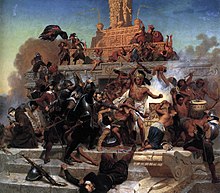
After landing in Veracruz, Spanish explorer Hernán Cortés advanced upon Tenochtitlan with the aid of many of the other native peoples,[49] arriving there on 8 November 1519.[50] Cortés and his men marched along the causeway leading into the city from Iztapalapa (Ixtapalapa), and the city's ruler, Moctezuma II, greeted the Spaniards; they exchanged gifts, but the camaraderie did not last long.[51] Cortés put Moctezuma under house arrest, hoping to rule through him.[52]
Tensions increased until, on the night of 30 June 1520 – during a struggle known as "La Noche Triste" – the Aztecs rose up against the Spanish intrusion and managed to capture or drive out the Europeans and their Tlaxcalan allies.[53] Cortés regrouped at Tlaxcala. The Aztecs thought the Spaniards were permanently gone, and they elected a new king, Cuitláhuac, but he soon died; the next king was Cuauhtémoc.[54] Cortés began a siege of Tenochtitlan in May 1521. For three months, the city suffered from the lack of food and water as well as the spread of smallpox brought by the Europeans.[49] Cortés and his allies landed their forces in the south of the island and slowly fought their way through the city.[55] Cuauhtémoc surrendered in August 1521.[49] The Spaniards practically razed Tenochtitlan during the final siege of the conquest.[50]
Cortés first settled in Coyoacán, but decided to rebuild the Aztec site to erase all traces of the old order.[50] He did not establish a territory under his own personal rule, but remained loyal to the Spanish crown. The first Spanish viceroy arrived in Mexico City fourteen years later. By that time, the city had again become a city-state, having power that extended far beyond its borders.[56] Although the Spanish preserved Tenochtitlan's basic layout, they built Catholic churches over the old Aztec temples and claimed the imperial palaces for themselves.[56] Tenochtitlan was renamed "Mexico" because the Spanish found the word easier to pronounce.[50]
Growth of colonial Mexico City

The city had been the capital of the Aztec Empire and in the colonial era, Mexico City became the capital of New Spain. The viceroy of Mexico or vice-king lived in the viceregal palace on the main square or Zócalo. The Mexico City Metropolitan Cathedral, the seat of the Archbishopric of New Spain, was constructed on another side of the Zócalo, as was the archbishop's palace, and across from it the building housing the city council or ayuntamiento of the city. A late seventeenth-century painting of the Zócalo by Cristóbal de Villalpando depicts the main square, which had been the old Aztec ceremonial center. The existing central plaza of the Aztecs was effectively and permanently transformed to the ceremonial center and seat of power during the colonial period, and remains to this day in modern Mexico, the central plaza of the nation. The rebuilding of the city after the siege of Tenochtitlan was accomplished by the abundant indigenous labor in the surrounding area. Franciscan friar Toribio de Benavente Motolinia, one of the Twelve Apostles of Mexico who arrived in New Spain in 1524, described the rebuilding of the city as one of the afflictions or plagues of the early period:
The seventh plague was the construction of the great City of Mexico, which, during the early years used more people than in the construction of Jerusalem. The crowds of laborers were so numerous that one could hardly move in the streets and causeways, although they are very wide. Many died from being crushed by beams, or falling from high places, or in tearing down old buildings for new ones.[57]

Preconquest Tenochtitlan was built in the center of the inland lake system, with the city reachable by canoe and by wide causeways to the mainland. The causeways were rebuilt under Spanish rule with indigenous labor. Colonial Spanish cities were constructed on a grid pattern, if no geographical obstacle prevented it. In Mexico City, the Zócalo (main square) was the central place from which the grid was then built outward. The Spanish lived in the area closest to the main square in what was known as the traza, in orderly, well laid-out streets. Indigenous residences were outside that exclusive zone and houses were haphazardly located.[58] Spaniards sought to keep indigenous people separate but since the Zócalo was a center of commerce for Amerindians, they were a constant presence in the central area, so strict segregation was never enforced.[59] At intervals Zócalo was where major celebrations took place as well as executions. It was also the site of two major riots in the seventeenth century, one in 1624, the other in 1692.[60]
The city grew as the population did, coming up against the lake's waters. As the depth of the lake water fluctuated, Mexico City was subject to periodic flooding. A major labor draft, the desagüe, compelled thousands of indigenous over the colonial period to work on infrastructure to prevent flooding. Floods were not only an inconvenience but also a health hazard, since during flood periods human waste polluted the city's streets. By draining the area, the mosquito population dropped as did the frequency of the diseases they spread. However, draining the wetlands also changed the habitat for fish and birds and the areas accessible for indigenous cultivation close to the capital.[61] The 16th century saw a proliferation of churches, many of which can still be seen today in the historic center.[56] Economically, Mexico City prospered as a result of trade. Unlike Brazil or Peru, Mexico had easy contact with both the Atlantic and Pacific worlds. Although the Spanish crown tried to completely regulate all commerce in the city, it had only partial success.[62]

The concept of nobility flourished in New Spain in a way not seen in other parts of the Americas. Spaniards encountered a society in which the concept of nobility mirrored that of their own. Spaniards respected the indigenous order of nobility and added to it. In the ensuing centuries, possession of a noble title in Mexico did not mean one exercised great political power, for one's power was limited even if the accumulation of wealth was not.[63] The concept of nobility in Mexico was not political but rather a very conservative Spanish social one, based on proving the worthiness of the family. Most of these families proved their worth by making fortunes in New Spain outside of the city itself, then spending the revenues in the capital, building churches, supporting charities and building extravagant palatial homes. The craze to build the most opulent residence possible reached its height in the last half of the 18th century. Many of these palaces can still be seen today, leading to Mexico City's nickname of "The city of palaces" given by Alexander Von Humboldt.[50][56][63]
The Grito de Dolores ("Cry of Dolores"), also known as El Grito de la Independencia ("Cry of Independence"), marked the beginning of the Mexican War of Independence. The Battle of Guanajuato, the first major engagement of the insurgency, occurred four days later. After a decade of war, Mexico's independence from Spain was effectively declared in the Declaration of Independence of the Mexican Empire on 27 September 1821.[64] Agustín de Iturbide is proclaimed Emperor of the First Mexican Empire by Congress, crowned in the Cathedral of Mexico. Unrest followed for the next several decades, as different factions fought for control of Mexico.[citation needed]
The Mexican Federal District was established by the new government and by the signing of their new constitution, where the concept of a federal district was adapted from the United States Constitution.[65] Before this designation, Mexico City had served as the seat of government for both the State of Mexico and the nation as a whole. Texcoco de Mora and then Toluca became the capital of the State of Mexico.[66]
Battle of Mexico City in the U.S.–Mexican War of 1847

During the 19th century, Mexico City was the center stage of all the political disputes of the country. It was the imperial capital on two occasions (1821–1823 and 1864–1867), and of two federalist states and two centralist states that followed innumerable coups d'états in the space of half a century before the triumph of the Liberals after the Reform War. It was also the objective of one of the two French invasions to Mexico (1861–1867), and occupied for a year by American troops in the framework of the Mexican–American War (1847–1848).
The Battle for Mexico City was the series of engagements from 8 to 15 September 1847, in the general vicinity of Mexico City during the U.S. Mexican War. Included are major actions at the battles of Molino del Rey and Chapultepec, culminating with the fall of Mexico City. The U.S. Army under Winfield Scott scored a major success that ended the war. The American invasion into the Federal District was first resisted during the Battle of Churubusco on 8 August, where the Saint Patrick's Battalion, which was composed primarily of Catholic Irish and German immigrants but also Canadians, English, French, Italians, Poles, Scots, Spaniards, Swiss, and Mexicans, fought for the Mexican cause, repelling the American attacks. After defeating the Saint Patrick's Battalion, the Mexican–American War came to a close after the United States deployed combat units deep into Mexico resulting in the capture of Mexico City and Veracruz by the U.S. Army's 1st, 2nd, 3rd and 4th Divisions.[67] The invasion culminated with the storming of Chapultepec Castle in the city itself.[68]
During this battle, on 13 September, the 4th Division, under John A. Quitman, spearheaded the attack against Chapultepec and carried the castle. Future Confederate generals George E. Pickett and James Longstreet participated in the attack. Serving in the Mexican defense were the cadets later immortalized as Los Niños Héroes (the "Boy Heroes"). The Mexican forces fell back from Chapultepec and retreated within the city. Attacks on the Belén and San Cosme Gates came afterwards. The treaty of Guadalupe Hidalgo was signed in what is now the far north of the city.[69]
Porfirian era (1876–1911)

Events such as the Mexican–American War, the French Intervention and the Reform War left the city relatively untouched and it continued to grow, especially during the rule of President Porfirio Díaz. During this time the city developed a modern infrastructure, such as roads, schools, transportation systems and communication systems. However the regime concentrated resources and wealth into the city while the rest of the country languished in poverty.
Under the rule of Porfirio Díaz, Mexico City experienced a massive transformation. Díaz's goal was to create a city which could rival the great European cities. He and his government came to the conclusion that they would use Paris as a model, while still containing remnants of Amerindian and Hispanic elements. This style of Mexican-French fusion architecture became colloquially known as Porfirian Architecture. Porfirian architecture became very influenced by Paris' Haussmannization.
During this era of Porfirian rule, the city underwent an extensive modernization. Many Spanish Colonial style buildings were destroyed, replaced by new much larger Porfirian institutions and many outlying rural zones were transformed into urban or industrialized districts with most having electrical, gas and sewage utilities by 1908. While the initial focus was on developing modern hospitals, schools, factories and massive public works, perhaps the most long-lasting effects of the Porfirian modernization were creation of the Colonia Roma area and the development of Reforma Avenue. Many of Mexico City's major attractions[citation needed] and landmarks were built during this era in this style.
Diaz's plans called for the entire city to eventually be modernized or rebuilt in the Porfirian/French style of the Colonia Roma; but the Mexican Revolution began soon afterward and the plans never came to fruition, with many projects being left half-completed. One of the best examples of this is the Monument to the Mexican Revolution. Originally the monument was to be the main dome of Diaz's new senate hall, but when the revolution erupted only the dome of the senate hall and its supporting pillars were completed, this was subsequently seen as a symbol by many Mexicans that the Porfirian era was over once and for all and as such, it was turned into a monument to victory over Diaz.
Mexican Revolution (1910–1920)
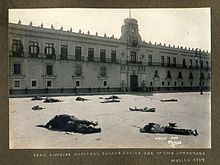
The capital escaped the worst of the violence of the ten-year conflict of the Mexican Revolution. The most significant episode of this period for the city was the Decena Trágica ("Ten Tragic Days") of February 1913, when forces counter to the elected government of Francisco I. Madero staged a successful coup. The center of the city was subjected to artillery attacks from the army stronghold of the ciudadela or citadel, with significant civilian casualties and the undermining of confidence in the Madero government. Victoriano Huerta, chief general of the Federal Army, saw a chance to take power, forcing Madero and Pino Suarez to sign resignations. The two were murdered later while on their way to Lecumberri prison.[71] Huerta's ouster in July 1914 saw the entry of the armies of Pancho Villa and Emiliano Zapata, but the city did not experience violence. Huerta had abandoned the capital and the conquering armies marched in. Venustiano Carranza's Constitutionalist faction ultimately prevailed in the revolutionary civil war and Carranza took up residence in the presidential palace.
20th century to present

In the 20th century the phenomenal growth of the city and its environmental and political consequences dominate. In 1900, the population of Mexico City was about 500,000.[72] The city began to grow rapidly westward in the early part of the 20th century[56] and then began to grow upwards in the 1950s, with the Torre Latinoamericana becoming the city's first skyscraper.[49]
The rapid development of Mexico City as a center for modernist architecture was most fully manifested in the mid-1950s construction of the Ciudad Universitaria, Mexico City, the main campus of the National Autonomous University of Mexico. Designed by the most prestigious architects of the era, including Mario Pani, Eugenio Peschard, and Enrique del Moral, the buildings feature murals by artists Diego Rivera, David Alfaro Siqueiros, and José Chávez Morado. It has since been recognized as a UNESCO World Heritage Site.[73]
The 1968 Olympic Games brought about the construction of large sporting facilities.[56] In 1969, the Mexico City Metro was inaugurated.[49] Explosive growth in the population of the city started in the 1960s, with the population overflowing the boundaries of the Federal District into the neighboring State of Mexico, especially to the north, northwest, and northeast. Between 1960 and 1980 the city's population more than doubled to nearly 9 million.[56]
In 1980, half of all the industrial jobs in Mexico were located in Mexico City. Under relentless growth, the Mexico City government could barely keep up with services. Villagers from the countryside who continued to pour into the city to escape poverty only compounded the city's problems. With no housing available, they took over lands surrounding the city, creating huge shantytowns that extended for many miles.[citation needed]
The inhabitants of Mexico City faced serious air pollution in Mexico City and water pollution problems, as well as groundwater-related subsidence.[74] Air and water pollution has been contained and improved in several areas due to government programs, the renovation of vehicles and the modernization of public transportation.
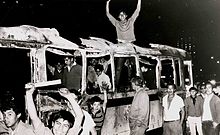
The autocratic government that ruled Mexico City since the Revolution was tolerated, mostly because of the continued economic expansion since World War II. This was the case even though this government could not handle the population and pollution problems adequately. Nevertheless, discontent and protests began in the 1960s leading to the massacre of an unknown number of protesting students in Tlatelolco.[75]
Three years later, a demonstration in the Maestros avenue, organized by former members of the 1968 student movement, was violently repressed by a paramilitary group called "Los Halcones", composed of gang members and teenagers from many sports clubs who received training in the U.S.
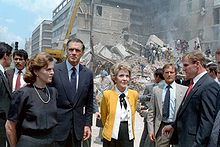
On Thursday, 19 September 1985, at 7:19 am Central Standard Time (CST), Mexico City was struck by an 1985 Mexico City earthquake.[76] The earthquake proved to be a disaster politically for the one-party state government. The Mexican government was paralyzed by its own bureaucracy and corruption, forcing ordinary citizens to create and direct their own rescue efforts and to reconstruct much of the housing that was lost as well.[77]
However, the last straw may have been the controversial elections of 1988. That year, the presidency was set between the P.R.I.'s candidate, Carlos Salinas de Gortari, and a coalition of left-wing parties led by Cuauhtémoc Cárdenas, son of the former president Lázaro Cárdenas. The counting system "fell" because coincidentally the power went out and suddenly, when it returned, the winning candidate was Salinas, even though Cárdenas had the upper hand.
As a result of the fraudulent election, Cárdenas became a member of the Party of the Democratic Revolution. Discontent over the election eventually led Cuauhtémoc Cárdenas to become the first elected mayor of Mexico City in 1997. Cárdenas promised a more democratic government, and his party claimed some victories against crime, pollution, and other major problems. He resigned in 1999 to run for the presidency.
Geography

Mexico City is located in the Valley of Mexico, sometimes called the Basin of Mexico. This valley is located in the Trans-Mexican Volcanic Belt in the high plateaus of south-central Mexico.[78][79]
It has a minimum altitude of 2,200 meters (7,200 feet) above sea level and is surrounded by mountains and volcanoes that reach elevations of over 5,000 meters (16,000 feet).[80] This valley has no natural drainage outlet for the waters that flow from the mountainsides, making the city vulnerable to flooding. Drainage was engineered through the use of canals and tunnels starting in the 17th century.[78][80]
Mexico City primarily rests on what was Lake Texcoco.[78] Seismic activity is frequent there.[81] Lake Texcoco was drained starting from the 17th century. Although none of the lake waters remain, the city rests on the lake bed's heavily saturated clay. This soft base is collapsing due to the over-extraction of groundwater, called groundwater-related subsidence.
Since the beginning of the 20th century the city has sunk as much as nine meters (30 feet) in some areas. On average Mexico City sinks 20 inches (1 foot and 8 inches) or 50 centimetres (1/2 meters) every year.[82] This sinking is causing problems with runoff and wastewater management, leading to flooding problems, especially during the summer.[80][81][83] The entire lake bed is now paved over and most of the city's remaining forested areas lie in the southern boroughs of Milpa Alta, Tlalpan and Xochimilco.[81]
| Mexico City geophysical maps | |||
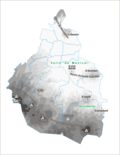
|
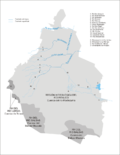
|
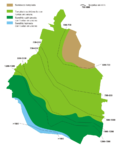
| |
| Topography | Hydrology | Climate patterns | |
Environment

Originally much of the valley lay beneath the waters of Lake Texcoco, a system of interconnected salt and freshwater lakes. The Aztecs built dikes to separate the fresh water used to raise crops in chinampas and to prevent recurrent floods. These dikes were destroyed during the siege of Tenochtitlan, and during colonial times the Spanish regularly drained the lake to prevent floods. Only a small section of the original lake remains, located outside Mexico City, in the municipality of Atenco, State of Mexico.
Architects Teodoro González de León and Alberto Kalach along with a group of Mexican urbanists, engineers and biologists have developed the project plan for Recovering the City of Lakes. If approved by the government the project will contribute to the supply of water from natural sources to the Valley of Mexico, the creation of new natural spaces, a great improvement in air quality, and greater population establishment planning.
Pollution

By the 1990s Mexico City had become infamous as one of the world's most polluted cities; however, the city has since become a model for drastically lowering pollution levels. By 2014 carbon monoxide pollution had dropped drastically, while sulfur dioxide and nitrogen dioxide were at levels about a third of those in 1992. The levels of signature pollutants in Mexico City are similar to those of Los Angeles.[84] Despite the cleanup, the metropolitan area is still the most ozone-polluted part of the country, with ozone levels 2.5 times beyond WHO-defined safe limits.[85]
To clean up pollution, the federal and local governments implemented numerous plans including the constant monitoring and reporting of environmental conditions, such as ozone and nitrogen oxides.[86] When the levels of these two pollutants reached critical levels, contingency actions were implemented which included closing factories, changing school hours, and extending the A day without a car program to two days of the week.[86] The government also instituted industrial technology improvements, a strict biannual vehicle emission inspection and the reformulation of gasoline and diesel fuels.[86] The introduction of Metrobús bus rapid transit and the Ecobici bike-sharing were among efforts to encourage alternate, greener forms of transportation.[85]
Parks and recreation

Chapultepec, the city's most iconic public park, has history back to the Aztec emperors who used the area as a retreat. It is south of Polanco district, and houses the Chapultepec Zoo the main city's zoo, several ponds and seven museums, including the National Museum of Anthropology. Other iconic city parks include the Alameda Central, it is recognized as the oldest public park in the Americas.[89][90] Parque México and Parque España in the hip Condesa district; Parque Hundido and Parque de los Venados in Colonia del Valle, and Parque Lincoln in Polanco.[91] There are many smaller parks throughout the city. Most are small "squares" occupying two or three square blocks amid residential or commercial districts. Several other larger parks such as the Bosque de Tlalpan and Viveros de Coyoacán, and in the east Alameda Oriente, offer many recreational activities. Northwest of the city is a large ecological reserve, the Bosque de Aragón. In the southeast is the Xochimilco Ecological Park and Plant Market, a World Heritage Site. West of Santa Fe district are the pine forests of the Desierto de los Leones National Park. Amusement parks include Six Flags México, in Ajusco neighborhood which is the largest in Latin America. There are numerous seasonal fairs present in the city.
Mexico City has three zoos. Chapultepec Zoo, the San Juan de Aragon Zoo and Los Coyotes Zoo. Chapultepec Zoo is located in the first section of Chapultepec Park in the Miguel Hidalgo. It was opened in 1924.[92] Visitors can see about 243 specimens of different species including kangaroos, giant panda, gorillas, caracal, hyena, hippos, jaguar, giraffe, lemur, lion, among others.[93] Zoo San Juan de Aragon is near the San Juan de Aragon Park in the Gustavo A. Madero. In this zoo, opened in 1964,[94] there are species that are in danger of extinction such as the jaguar and the Mexican wolf. Other guests are the golden eagle, pronghorn, bighorn sheep, caracara, zebras, African elephant, macaw, hippo, among others.[95] Zoo Los Coyotes is a 27.68-acre (11.2 ha) zoo located south of Mexico City in the Coyoacan. It was inaugurated on 2 February 1999.[96] It has more than 301 specimens of 51 species of wild native or endemic fauna from the area, featuring eagles, ajolotes, coyotes, macaws, bobcats, Mexican wolves, raccoons, mountain lions, teporingos, foxes, white-tailed deer.[97]
Climate

Mexico City has a subtropical highland climate (Köppen climate classification Cwb), due to its tropical location but high elevation. The lower region of the valley receives less rainfall than the upper regions of the south; the lower boroughs of Iztapalapa, Iztacalco, Venustiano Carranza and the east portion of Gustavo A. Madero are usually drier and warmer than the upper southern boroughs of Tlalpan and Milpa Alta, a mountainous region of pine and oak trees known as the range of Ajusco. The average annual temperature varies from 12 to 16 °C (54 to 61 °F), depending on the altitude of the borough. The temperature is rarely below 3 °C (37 °F) or above 30 °C (86 °F).[98] At the Tacubaya observatory, the lowest temperature ever registered was −4.4 °C (24 °F) on 13 February 1960, and the highest temperature on record was 33.9 °C (93 °F) on 9 May 1998.[99] Overall precipitation is heavily concentrated in the summer months, and includes dense hail.
Snow falls in the city very rarely, although somewhat more often in nearby mountaintops. Throughout its history, the Central Valley of Mexico was accustomed to having several snowfalls per decade (including a period between 1878 and 1895 in which every single year—except 1880—recorded snowfalls[100]), mostly lake-effect snow. The effects of the draining of Lake Texcoco and global warming have greatly reduced snowfalls after the snow flurries of 12 February 1907.[101] Since 1908, snow has only fallen three times, snow on 14 February 1920;[102] snow flurries on 14 March 1940;[103] and on 12 January 1967, when 8 centimeters (3 in) of snow fell on the city, the most on record.[104] The 1967 snowstorm coincided with the operation of Deep Drainage System that resulted in the total draining of what was left of Lake Texcoco.[100][105] After the disappearance of Lake Texcoco, snow has never fallen again over Mexico City.[100] The region of the Valley of Mexico receives anti-cyclonic systems. The weak winds of these systems do not allow for the dispersion, outside the basin, of the air pollutants which are produced by the 50,000 industries and 4 million vehicles operating in and around the metropolitan area.[106]
The area receives about 820 millimeters (32 in) of annual rainfall, which is concentrated from May through October with little or no precipitation the remainder of the year.[80] The area has two main seasons. The wet humid summer runs from May to October when winds bring in tropical moisture from the sea, the wettest month being July. The cool sunny winter runs from November to April, when the air is relatively drier, the driest month being December. This season is subdivided into a cold winter period and a warm spring period. The cold period spans from November to February, when polar air masses push down from the north and keep the air fairly dry. The warm period extends from March to May when subtropical winds again dominate but do not yet carry enough moisture for rain to form.[107]
| Climate data for Mexico City (Tacubaya), 1991–2020 normals, extremes 1877–2018 | |||||||||||||
|---|---|---|---|---|---|---|---|---|---|---|---|---|---|
| Month | Jan | Feb | Mar | Apr | May | Jun | Jul | Aug | Sep | Oct | Nov | Dec | Year |
| Record high °C (°F) | 28.2 (82.8) |
30.8 (87.4) |
32.9 (91.2) |
33.7 (92.7) |
33.9 (93.0) |
33.5 (92.3) |
29.6 (85.3) |
29.4 (84.9) |
28.6 (83.5) |
29.2 (84.6) |
31.5 (88.7) |
29.4 (84.9) |
33.9 (93.0) |
| Mean daily maximum °C (°F) | 22.3 (72.1) |
24.2 (75.6) |
26.0 (78.8) |
27.3 (81.1) |
27.1 (80.8) |
25.7 (78.3) |
24.4 (75.9) |
24.5 (76.1) |
23.6 (74.5) |
23.3 (73.9) |
22.7 (72.9) |
22.3 (72.1) |
24.5 (76.1) |
| Daily mean °C (°F) | 15.7 (60.3) |
17.1 (62.8) |
18.9 (66.0) |
20.4 (68.7) |
20.9 (69.6) |
19.9 (67.8) |
18.8 (65.8) |
19.1 (66.4) |
18.6 (65.5) |
18.0 (64.4) |
16.4 (61.5) |
15.5 (59.9) |
18.3 (64.9) |
| Mean daily minimum °C (°F) | 8.4 (47.1) |
9.4 (48.9) |
11.1 (52.0) |
13.0 (55.4) |
13.7 (56.7) |
13.8 (56.8) |
13.0 (55.4) |
13.1 (55.6) |
13.1 (55.6) |
11.8 (53.2) |
9.8 (49.6) |
8.4 (47.1) |
11.5 (52.7) |
| Record low °C (°F) | −4.2 (24.4) |
−4.4 (24.1) |
−4.0 (24.8) |
−0.6 (30.9) |
3.7 (38.7) |
0.0 (32.0) |
1.0 (33.8) |
1.0 (33.8) |
1.0 (33.8) |
0.0 (32.0) |
−3.0 (26.6) |
−3.0 (26.6) |
−4.4 (24.1) |
| Average precipitation mm (inches) | 12.5 (0.49) |
5.9 (0.23) |
11.7 (0.46) |
24.9 (0.98) |
62.5 (2.46) |
137.1 (5.40) |
177.1 (6.97) |
175.1 (6.89) |
160.2 (6.31) |
71.2 (2.80) |
17.6 (0.69) |
5.0 (0.20) |
860.8 (33.89) Zdroj:https://en.wikipedia.org?pojem=Mexico_City,_Mexico >Text je dostupný pod licencí Creative Commons Uveďte autora – Zachovejte licenci, případně za dalších podmínek. Podrobnosti naleznete na stránce Podmínky užití. Zdroj: Wikipedia.org - čítajte viac o Mexico City, Mexico
Text je dostupný za podmienok Creative
Commons Attribution/Share-Alike License 3.0 Unported; prípadne za ďalších
podmienok. |













